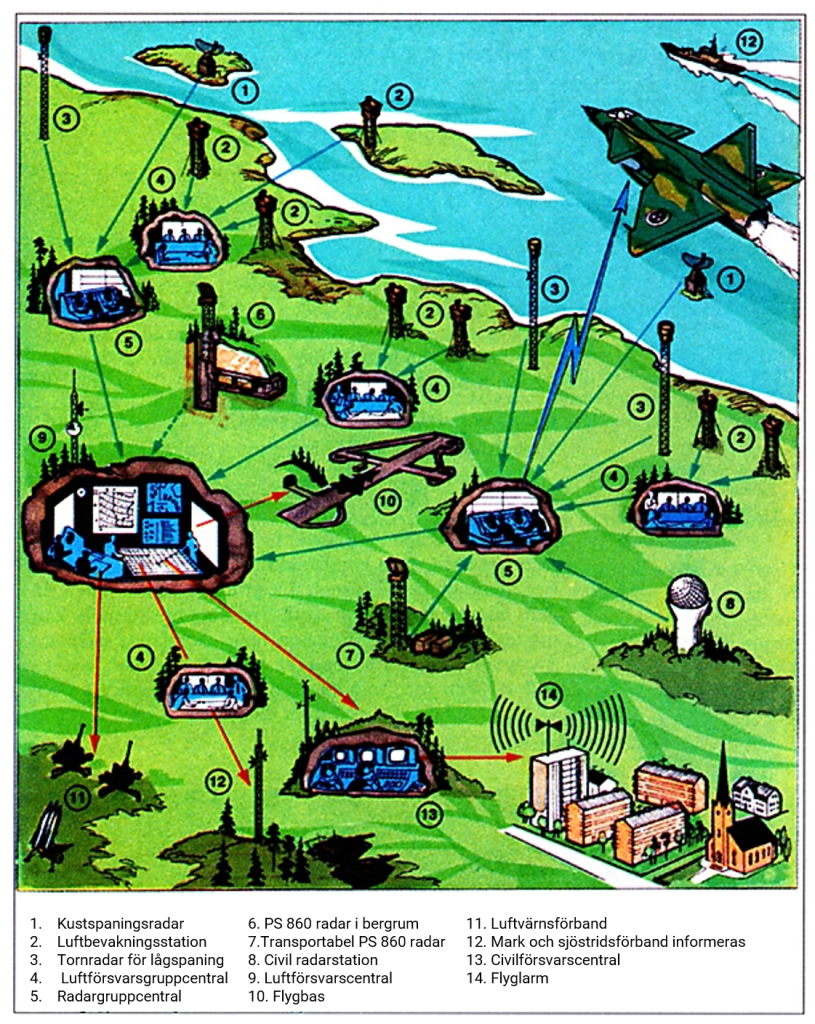The Saab J 35 Draken in the defence of Sweden.

It’s one thing to have good fighter aircraft, but another to be able to use them effectively. World War Two had shown how important it was to have efficient control of fighters, ensuring that they would appear at the right time and place, and be guided to the right targets.
Dogfighting against enemy fighters was and is not the main purpose for a defender. The aim is to attack incoming bombers and ground attack aircraft, along with transport aircraft that are trying to drop paratroops or other airborne infantry.
World-class fighter control
While the Draken was being designed, Sweden was developing a new fighter control system, with the Draken forming an essential part. The system became known as Stril 60, and in parallel a new air base organisation was set up called Bas 60.
The new organisation meant a change compared to previous planning concerned with fighter bases. The main idea was to create a number of nuclear bomb-proof underground hangars for suitable Wings of fighters, in which the fighters would be protected. One example of this was Nya Berget which now houses the Aeroseum. Saab developed the J 35 Draken on the basis the aircraft would be housed in such underground hangars. However, by the time the Draken entered squadron service, there had been a rethink.
Dispersed bases
It was now considered to be risky to have fighters grouped together in just a few locations, regardless of how heavily protected they would be. Instead, construction commenced of a large number of so-called dispersed bases around the country. These to some extent used the ordinary road system, that in certain places was complemented by additional runways, widened roads, military equipment stores and prepared weather and shrapnel protection. Having so many widely dispersed bases meant it would be impossible for an aggressor to know exactly where all the aircraft would be located at any particular time and it would thus be impossible to destroy every aircraft in a surprise attack.
Along with the new bases there was also an Air Force requirement that aircraft would be able to take off and land in short distances; called STOL (”Short Take-off and Landing”). For this purpose, the J 35 Draken was equipped with a braking parachute.
Digital technology long before its time

Image from a J35F cockpit. The two display modules presenting the digital information to the pilot is seen on both sides of the round radar screen.
On 29 June 1964 the first successful training mission was completed of a J 35 Draken being guided to its airborne target using only a digitally transmitted set of signals from an Air Defence Centre in Sweden. Information concerning the speed, height and course of the target was displayed on two special instruments in the Draken cockpit for the pilot to use, without any verbal communication between the fighter controller and the pilot.
This system was the only one of its kind in the world and top secret. Until then the fighter controller and pilot were forced to communicate via radio, and this method was fairly subject to interference. However the new Digital control system was much more resistant ro interference and there was no need for voice communication between the controller and the pilot. This would provide the J 35 and Swedish air defence with a considerable advantage in the case of a future conflict.
The sharp teeth of the Draken
In addition the weapon systems, not least the licence built radar-guided air-to-air missile RB 27 (AIM-26 Falcon), were subjected to continuous devekopment and upgrading. This missile originated in the USA but Sweden arranged a comprehensive licensing agreement, which allowed for continuous improvement and adaptation to new circumstances.
LM Ericsson of Mölndal had right from the start been engaged to manufacture a better semi-active radar guidance system for the missile. The system ensures that the missile will detonate anywhere close to the target, i.e. a direct hit is not necessary. This increases the chance of damaging an enemy aircraft.
From the start the intention was to shoot down high flying bombers, but gradually the main objective became to catch low-flying ground attack aircraft, necessitating changes in tactics and technology. The RB 27 kept pace all the way, until the last Draken was retired from the Swedish Air Force.
